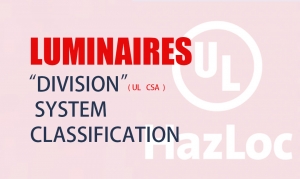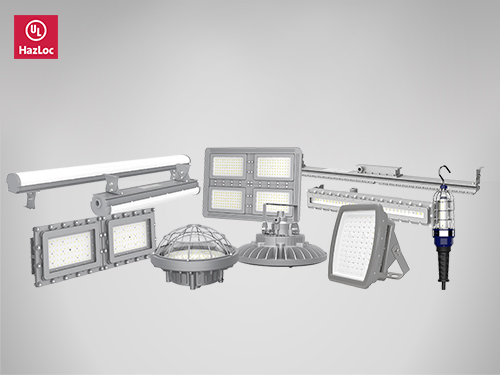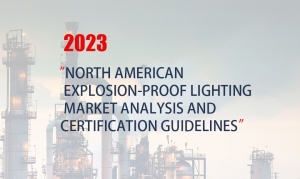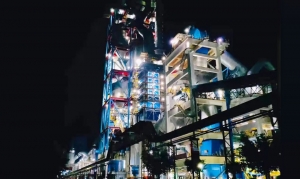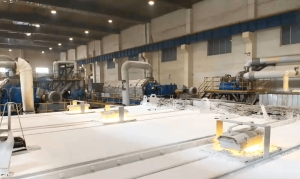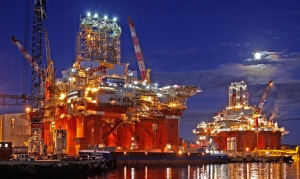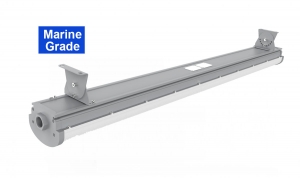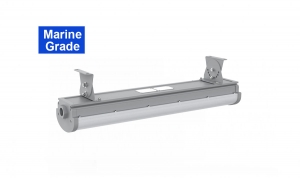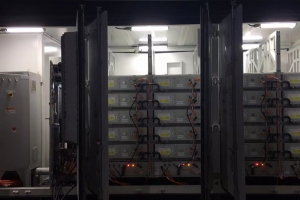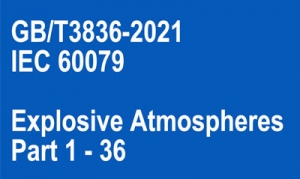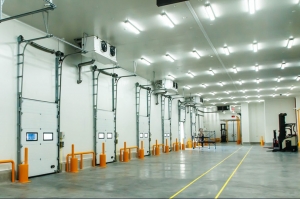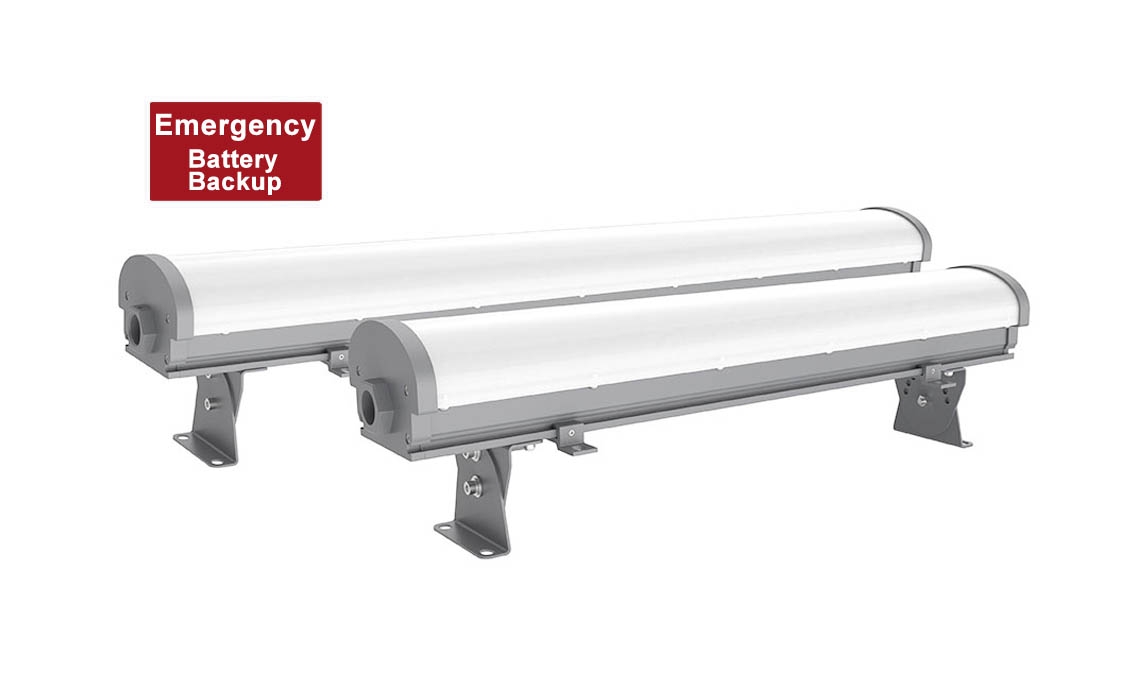Explosion Proof LED Lamps of The Division System
Explosion-proof LED lamps that are designed for use in division systems must meet stringent safety requirements to prevent the ignition of flammable gases, vapors, or dust. There are five classes of division explosion-proof systems, each with its own set of conditions, and LED lamps must meet the requirements of the specific class in which they will be used.
Class 1 Division 1 (C1D1): This is the most hazardous location, where ignitable concentrations of flammable gases, vapors, or liquids are present continuously or frequently. LED lamps designed for use in Class 1 Division 1 location must be hermetically sealed and designed to withstand and contain any potential explosions. They must also be made of non-sparking materials and meet rigorous testing requirements to ensure they can operate safely under normal and fault conditions.
Class 2 Division 1 (C1D2): This is a location where combustible dust is present in the air in sufficient quantities to create a hazardous condition. LED lamps designed for use in Class 2 Division 1 locations must be designed and tested to prevent the ignition of dust particles and must be made of non-sparking materials to prevent sparking.
Class 1 Division 2 (C2D1): This is a location where ignitable concentrations of flammable gases, vapors, or liquids are present, but only under abnormal conditions or during equipment failure. LED lamps designed for use in Class 1 Division 2 locations must be designed to prevent the ignition of flammable materials under normal operating conditions and must be made of non-sparking materials to prevent sparking.
Class 2 Division 2 (C2D2): This is a location where combustible dust is present, but only under abnormal conditions or during equipment failure. LED lamps designed for use in Class 2 Division 2 locations must be designed and tested to prevent the ignition of dust particles and make non-sparking materials to prevent sparking.
Class III: This class applies to locations where ignitable fibers or flyings are present, such as in textile mills or woodworking shops. LED lamps designed for use in Class III locations must be designed and tested to prevent the ignition of these materials and must be made of non-sparking materials to prevent sparking.
Choose a Better Division System Ex-proof Lights from CESP
In addition to meeting the requirements of the specific class in which they will be used, LED lamps for division explosion-proof systems must also comply with other standards and certifications, such as UL Listing, CSA Certification, ATEX Certification, FM Approval, or IECEx Certification, to ensure their safety and effectiveness.
When it comes to hazardous work environments, proper lighting is crucial for ensuring safety and productivity. That's why the National Electric Code (NEC) has established guidelines for the use of electrical equipment in areas where explosive gases, dust, or other combustible materials may be present. These guidelines classify hazardous areas into four different classes, and each class has two divisions, which are used to determine the level of protection required for electrical equipment.
Class 1 Div 1 Lighting:
Class 1 Div 1 LED lights are designed for use in areas where explosive gases or vapors are present continuously or intermittently under normal operating conditions. These areas are typically found in petroleum refineries, chemical plants, and other similar facilities. Class 1 Div 1 LED lights are required to be explosion-proof, which means they must be able to withstand an explosion without igniting the surrounding gases or vapors. They must also be able to operate at temperatures that are high enough to prevent the formation of explosive gases or vapors.
Class 1 Div 2 Lighting:
Class 1 Div 2 LED lights are designed for use in locations where flammable gases or vapors may be present under abnormal conditions. These lights are suitable for use in Class I, Division 2 hazardous locations as defined in NEC Article 500. Class 1 Div 2 LED lights are designed to be spark-free and feature explosion-proof enclosures to prevent the ignition of hazardous substances in the surrounding environment. They are commonly used in oil refineries, chemical plants, and other industrial facilities where flammable gases or vapors are present.
Class 2 Div 1 Lighting:
Class 2 Div 1 LED lights are designed for use in areas where combustible dust is present continuously or intermittently under normal operating conditions. These lights are suitable for use in Class II, Division 1 hazardous location as defined in NEC Article 502. Class 2 Div 1 LED lights are designed to prevent the ignition of combustible dust in the surrounding environment by using dust-tight enclosures and non-sparking materials. They are commonly used in grain elevators, flour mills, and other facilities where combustible dust is present.
Class 2 Div 2 Lighting:
Class 2 Div 2 LED lights are designed for use in locations where combustible dust may be present under normal operating conditions such as during maintenance or cleaning. These lights are suitable for use in Class II, Division 2 hazardous locations as defined in NEC Article 502. Class 2 Div 2 LED lights are designed to prevent the ignition of combustible dust in the surrounding environment by using dust-resistant enclosures and other protective measures. They are commonly used in food processing facilities, pharmaceutical plants, and other facilities where combustible dust is present.
In conclusion, selecting the appropriate LED light for hazardous locations requires careful consideration of the specific conditions present in each location. By understanding the NEC guidelines for Class 1 Div 1, Class 1 Div 2, Class 2 Div 1, and Class 2 Div 2 areas, you can make informed decisions to ensure the safety of your workers and equipment.
At our company, we offer UL844 class 1 division 1 and class 1 division 2 LED lights that provide safe and efficient illumination in hazardous locations. Our class 1 division 1 LED lights are explosion-proof and ruggedly constructed, making them suitable for areas with flammable gases or vapors. Our class 1 division 2 LED lights are cost-effective and designed for areas where flammable gases or vapors are not typically present but may be accidentally present. Both LED lights are highly energy-efficient and have a long lifespan, reducing maintenance needs and electricity bills.
Choosing our UL844 class 1 division 1 and class 1 division 2 LED lights ensures a reliable and safe lighting solution for hazardous locations. Contact us today to learn more about our products and how they can meet your lighting needs.
Visit: https://cespledex.com/products/ul-hazloc-certified-led-luminaires
2023 North American Explosion Proof Lighting Market Analysis and Certification Guidelines
Analysis of the North American Explosion-Proof Lights Market Situation
The North American explosion-proof light market is driven by the increasing demand for explosion-proof lighting systems across various end-use industries, including oil and gas, chemicals, mining, and pharmaceuticals. These industries have strict safety regulations, which have led to a growing need for explosion-proof lighting systems to prevent accidents and ensure worker safety.
Market Size:
The North American Explosion Proof Lighting Market has been growing steadily in recent years due to increasing safety regulations and the need for reliable and durable lighting solutions in hazardous environments. According to a report by MarketsandMarkets, the North American Explosion Proof Lighting Market was valued at USD 307.4 million in 2020 and is projected to reach USD 376.2 million by 2025, with a CAGR of 4.1% during the forecast period (2020-2025).
The United States is the largest market for explosion-proof light in North America, due to its large oil and gas industry and the presence of major players in the region. The Canadian market is also growing, driven by increasing investments in the mining and oil and gas industries.
Key Drivers:
Several factors are driving the growth of the North American Explosion Proof Lighting Market:
1. Stringent Safety Regulations: The increasing focus on workplace safety and the implementation of stringent regulations by regulatory bodies such as Occupational Safety and Health Administration (OSHA) and National Fire Protection Association (NFPA) are driving the demand for explosion-proof lighting solutions in North America.
2. Growth in Hazardous Industries: The growth of industries such as oil and gas, petrochemicals, chemicals, and mining in North America is creating a demand for explosion-proof lighting solutions. These industries often operate in hazardous environments where the risk of explosions is high, and reliable lighting solutions are required for safe operations.
3. Technological Advancements: Advancements in lighting technologies, such as LED (Light Emitting Diode) and induction lighting, are driving the adoption of explosion-proof lighting solutions. LED-based explosion-proof lighting fixtures are energy-efficient, long-lasting, and provide bright illumination, making them ideal for hazardous environments.
4. Retrofitting of Existing Infrastructure: The retrofitting of existing lighting infrastructure in hazardous environments with explosion-proof lighting solutions is also driving the demand for these products in North America. Many industrial facilities are upgrading their lighting systems to comply with safety regulations and improve operational efficiency, which is creating opportunities for explosion-proof lighting manufacturers.
Challenges:
However, the market also faces some challenges, including the high cost of explosion-proof lighting systems, which may limit their adoption in some industries, as well as the increasing competition from other lighting solutions such as LED bulbs and fixtures., including:
1. High Cost: Explosion-proof lighting fixtures are typically more expensive than regular lighting fixtures due to their specialized design and construction to withstand hazardous environments. The high cost of these fixtures may pose a challenge to small and medium-sized enterprises (SMEs) with limited budgets.
2. Rapid Technological Changes: The lighting industry is constantly evolving with new technologies and innovations. Keeping up with these rapid changes and incorporating the latest technologies into explosion-proof lighting fixtures may be a challenge for manufacturers, especially smaller players with limited resources.
3. Competition from Substitutes: There may be competition from alternative lighting solutions such as portable explosion-proof lighting equipment, temporary lighting solutions, or use of natural light in certain applications, which may impact the demand for fixed explosion-proof lighting fixtures.
Key players in the North American explosion-proof luminaires market include Dialight, Eaton Corporation, Hubbell Incorporated, Acuity Brands Lighting, and Emerson Electric Co. These companies are focusing on developing innovative and energy-efficient lighting solutions to meet the growing demand for explosion-proof light in the region.
The North American explosion-proof light market is expected to continue growing in the coming years, driven by increasing safety regulations, technological advancements, and the growing demand for energy-efficient lighting solutions.
Standards and Requirements for explosion-proof Lamps in North America
Explosion-proof lamps are lighting fixtures designed to prevent the ignition of hazardous materials in potentially explosive environments. In North America, there are several standards and requirements that explosion-proof lamps must meet to ensure their safety and effectiveness.
In the United States, the Occupational Safety and Health Administration (OSHA) sets standards for explosion-proof lighting in hazardous locations, which are defined as areas where the potential for fire or explosion exists due to the presence of flammable gases, vapors, liquids, or combustible dust. OSHA requires that all lighting fixtures in hazardous locations be explosion-proof, which is designed to contain any potential explosions within the fixture, preventing them from spreading into the surrounding environment.
In addition to OSHA standards, explosion-proof lighting fixtures in the United States must also comply with the National Electrical Code (NEC), which sets safety standards for electrical installations. The NEC outlines requirements for the design, construction, and installation of explosion-proof fixtures, as well as the types of hazardous locations where they can be used.
In Canada, explosion-proof lighting fixtures must comply with the Canadian Electrical Code (CEC), which is similar to the NEC in the United States. The CEC sets safety standards for electrical installations and equipment in hazardous locations, including requirements for the design, construction, and installation of explosion-proof fixtures.
Overall, explosion-proof lighting fixtures in North America must meet strict safety standards to ensure their effectiveness and prevent potential accidents in hazardous environments.
What certificates are required for explosion-proof lamps in North America
In North America, explosion-proof lamps must comply with certain certification requirements to ensure their safety and suitability for use in hazardous environments. The following are some of the most common certification requirements for explosion-proof lamps in North America:
- UL Listing: UL (Underwriters Laboratories) is a leading certification organization that tests and certifies products for safety and performance. Explosion-proof lamps must be UL listed to ensure they meet safety standards and comply with regulations in the United States.
- CSA Certification: CSA (Canadian Standards Association) is a certification organization that tests and certifies products for safety and performance in Canada. Explosion-proof lamps must be CSA certified to ensure they meet safety standards and comply with regulations in Canada.
- ATEX Certification: ATEX is a certification requirement for explosion-proof lamps used in the European Union. However, it may also be required in North America for lamps that are used in global applications. ATEX certification ensures that the lamps meet safety standards and comply with regulations in the European Union.
- FM Approval: FM (Factory Mutual) is a certification organization that tests and certifies products for safety and performance. FM approval is often required for explosion-proof lamps used in the United States to ensure they meet safety standards and comply with regulations.
- IECEx Certification: IECEx is a certification requirement for explosion-proof lamps used in international applications. IECEx certification ensures that the lamps meet safety standards and comply with regulations in countries that recognize the IECEx scheme.
The certificates are not the same, and there will be some differences in the standards. Normal, most North American customers accept division explosion-proof system
The difference between the division explosion-proof system and the zone explosion-proof system
Division explosion-proof systems and zone explosion-proof systems are both types of electrical systems designed to prevent explosions in hazardous environments. However, they differ in the way they classify and regulate hazardous locations.
In North America, the division explosion-proof system is commonly used and is based on the National Electrical Code (NEC). The division system divides hazardous locations into two groups: Division 1 and Division 2. Division 1 locations are those where explosive gases, vapors, or dusts are present continuously or intermittently, while Division 2 locations are those where these materials are handled, processed, or stored but are not normally present in the air in explosive concentrations.
In a division explosion-proof system, electrical equipment installed in Division 1 locations must be designed and tested to prevent the ignition of explosive materials under normal operating conditions and fault conditions, such as short circuits and ground faults. Equipment installed in Division 2 locations is designed to prevent the ignition of explosive materials under normal operating conditions only.
In contrast, the zone explosion-proof system is used in Europe, Asia, and other parts of the world and is based on the International Electrotechnical Commission (IEC) standards. The zone system divides hazardous locations into three zones: Zone 0, Zone 1, and Zone 2. Zone 0 locations are those where explosive gases, vapors, or dust are present continuously or for long periods, while Zone 1 locations are those where these materials are likely to be present in normal operating conditions, and Zone 2 locations are those where these materials are unlikely to be present but may occur for short periods of time.
In a zone explosion-proof system, electrical equipment installed in Zone 0 locations must be designed and tested to prevent the ignition of explosive materials under normal operating conditions and fault conditions. Equipment installed in Zone 1 locations is designed to prevent ignition of explosive materials under normal operating conditions, and in Zone 2 locations, the equipment is designed to prevent the formation of sparks or arcs that could ignite explosive materials.
Overall, both division and zone explosion-proof systems are designed to prevent explosions in hazardous environments, but they differ in the way they classify hazardous locations and regulate the design and testing of electrical equipment.
Explosion Proof Lighting for The Cement Plants
Cement plants often have areas where explosive or flammable materials are present, such as coal dust, petroleum coke, or other volatile substances used in the cement-making process. In such areas, it is essential to use explosion-proof lighting fixtures to prevent accidents caused by sparks or overheating from standard lighting sources.

Explosion-proof lamps are specially designed to withstand and contain any internal explosion, preventing it from igniting the surrounding flammable substances. They are built with materials that can withstand high temperatures, corrosion, and impact, and are sealed to prevent dust and other debris from entering and igniting.
By using explosion-proof lighting fixtures in cement plants, the risk of fire or explosion is significantly reduced, providing a safer working environment for employees and preventing damage to equipment and infrastructure. Additionally, the use of explosion-proof lamps is often required by law or safety regulations to ensure compliance with safety standards and prevent accidents.
One of the areas in a cement plant that requires proper lighting is the preheater tower. This tower is used to preheat the raw meal before it enters the kiln. The temperature inside the tower can exceed 1,000°C, and dust and debris are constantly present. It is essential to have a lighting system that can withstand these conditions and provide clear and bright illumination.
To address the challenges of the preheater tower lighting environment, it is recommended to use explosion-proof lights. CESP's explosion-proof lights are an excellent solution for this application. They are designed to operate in hazardous environments and can withstand extreme temperatures and harsh conditions.
CESP's explosion-proof lights use LED technology, which is up to 80% more efficient than traditional lighting sources. This means that they can help to reduce energy consumption and lower operating costs for the cement plant. They also have a long lifespan, which reduces maintenance and replacement costs.
Another area in the cement plant that requires proper lighting is the grinding area. The grinding area is where the clinker is ground into cement. This area can be dark and dusty, making it challenging to see and work safely. To address this issue, it is recommended to use high bay LED lights. CESP's high bay LED lights are an excellent solution for this application. They provide bright and clear illumination, and their energy efficiency can help to reduce energy consumption and operating costs for the cement plant.
In conclusion, the lighting environment in a cement plant can be challenging due to the harsh conditions. To address these challenges, it is recommended to use explosion-proof lights in the preheater tower and high bay LED lights in the grinding area. CESP's explosion-proof lights and high bay LED lights are excellent solutions for these applications, providing clear and bright illumination while also helping to reduce energy consumption and operating costs.
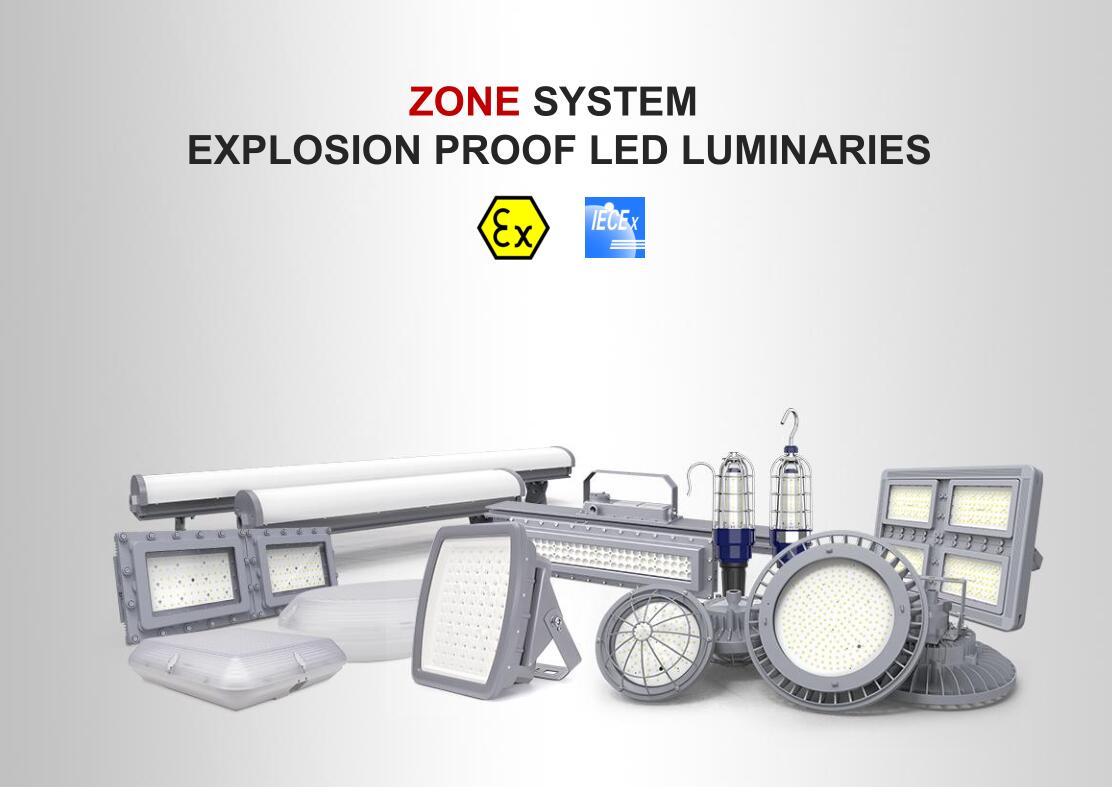
Advice on lighting lux for cement plants
The required lux level for lighting in a cement plant depends on the specific area and task being performed. Generally, higher lux levels are needed in areas where precise tasks are being carried out, such as inspection and maintenance, while lower levels may be sufficient in areas where general visibility is needed.
For example, in the preheater tower where workers are carrying out tasks such as inspecting equipment or conducting maintenance, a lux level of at least 500 lux is recommended. In the grinding area, where workers are grinding the clinker into cement, a lux level of around 200 lux may be sufficient.
It is important to note that the lux levels may vary depending on the specific guidelines and regulations of the country and the company. Additionally, factors such as the height and size of the area, reflectivity of surfaces, and the color of the light used can also affect the required lux levels.
To design and calculate lighting effects for your cement plant, please contact us immediately.
The lighting requirement of paper mill
What is the lighting requirement of paper mill?
The lighting requirement of a paper mill would depend on a number of factors, including the size of the facility, the type of operations being conducted, and any applicable safety regulations or standards.
In general, paper mills require high levels of lighting to ensure safe and efficient operations. Areas where workers are handling paper, machinery, or chemicals typically require brighter lighting than administrative areas. The lighting must also be designed to minimize shadows and glare, as these can increase the risk of accidents.
In addition to meeting basic lighting requirements, paper mills may need to comply with specific regulations or industry standards related to lighting. For example, the Occupational Safety and Health Administration (OSHA) has established guidelines for lighting in workplaces, including minimum illumination levels for different types of tasks.
Ultimately, the lighting requirements of a paper mill will depend on the specific needs and circumstances of the facility, and may require the expertise of a lighting consultant or lighting design engineer to ensure compliance with applicable regulations and standards.
Why do paper mills use explosion-proof lights?
Paper mills often use explosion-proof lights for safety reasons. Explosion-proof lights are designed to prevent the ignition of flammable materials in hazardous environments, which can help to reduce the risk of explosions and fires.
In paper mills, there are many areas where explosive dust or gases may be present, such as in pulp storage areas, paper drying machines, and chemical storage areas. These environments can create a hazardous condition that could lead to an explosion or fire if an electrical spark or heat source comes into contact with the flammable materials.
Explosion-proof lights are designed to prevent this from happening. They are constructed with specialized components and materials that can contain any sparks or heat that may be generated by the light. This reduces the risk of ignition and explosion in hazardous environments, making it safer for workers and reducing the likelihood of damage to equipment and facilities.
In summary, paper mills use explosion-proof lights as a safety measure to reduce the risk of fires and explosions in hazardous environments where flammable materials are present.
LED luminaires for paper mill
Here, I can recommend some cost-efficient explosion-proof floodlights and linear lights for your paper mill lighting project.
For the floodlights, we would recommend the following:
CES-J150 Explosion Proof Flood Light - This light has a 150-watt LED lamp that provides 17,500 lumens of light output. It is made with copper-free aluminum and has a tempered glass lens for protection. It is suitable for use in Class II, Division 2 or Zone 21 hazardous locations of the paper mill.
For the linear lights, we would recommend the following:
CES-EX-LN-02P LED Linear - from 20W to 80W that provides up to 9600 lumens of light output. It is made with copper-free aluminum and has a PC cover for protection. It is suitable for use in Class I, Division 2 or Zone 1 hazardous locations.
We hope this helps! Please ask the Dialux design solution.

Marine Lighting Requirements and Solutions
Introduction
The use of LED lamps in marine environments has increased significantly in recent years. This is due to the many advantages offered by LED technology over traditional lighting technologies, including energy efficiency, durability, and environmental friendliness. However, there are some specific challenges that must be considered when designing and using LED lamps in marine environments. In this article, we will analyze the various aspects of LED lamps used in marine environments in detail.
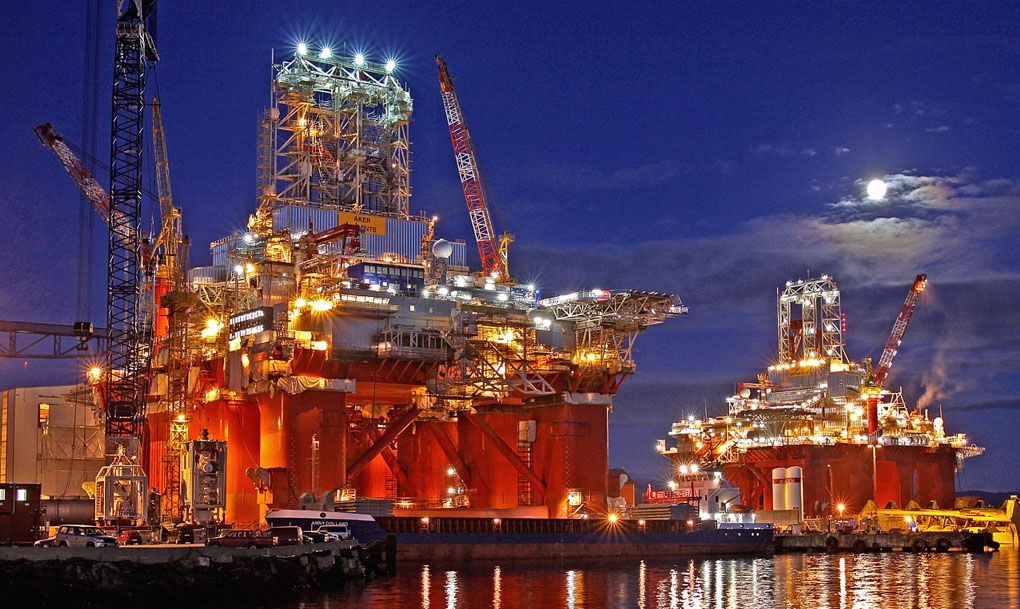
Environmental Factors Affecting LED Lamps in Marine Environment
Marine environments are harsh environments with various factors that can affect the performance of LED lamps. Some of the environmental factors that can affect LED lamps in marine environments are:
Salinity: Salinity is a critical factor that can affect the performance of LED lamps in marine environments. High salt content in seawater can corrode LED lamps, leading to premature failure.
Moisture: Moisture can also affect the performance of LED lamps in marine environments. The high humidity levels in marine environments can cause condensation inside the LED lamps, which can lead to short circuits and corrosion.
Temperature: Temperature fluctuations in marine environments can also affect the performance of LED lamps. Extreme temperature changes can cause thermal stress on LED lamps, leading to failure.
UV Radiation: UV radiation is another environmental factor that can affect LED lamps in marine environments. Prolonged exposure to UV radiation can cause the yellowing of LED lamps' lenses, leading to a decrease in light output.
Design Considerations for LED Lamps Used in Marine Environments
To ensure the reliable performance of LED lamps in marine environments, it is essential to consider the following design considerations:
Enclosure: LED lamps used in marine environments must be enclosed in a durable, waterproof, and corrosion-resistant housing. The housing should be designed to protect the internal components of the LED lamp from exposure to saltwater, moisture, and other environmental factors.
Heat Dissipation: LED lamps generate heat during operation, and it is essential to dissipate this heat to ensure their reliable performance. In marine environments, it is essential to consider the cooling system's design to prevent corrosion and damage to the LED lamps' internal components.
Optics: Optics is an essential design consideration for LED lamps used in marine environments. The optics must be designed to ensure that the LED lamps' light output is directed precisely where it is needed, minimizing light pollution and maximizing efficiency.
Power Supply: LED lamps require a power supply to operate, and the power supply's design is critical to their reliable performance. In marine environments, it is essential to consider the power supply's waterproofing, corrosion resistance, and protection from voltage fluctuations.
Applications of LED Lamps in Marine Environments
LED lamps find numerous applications in marine environments, including:
Navigation Lights: Navigation lights are essential in marine environments to ensure the safe navigation of vessels. LED lamps are ideal for navigation lights due to their high efficiency, reliability, and long life.
Underwater Lighting: LED lamps are increasingly being used for underwater lighting in marine environments. Underwater LED lamps offer several advantages, including low power consumption, durability, and high color rendering index.
Deck Lighting: LED lamps are also commonly used for deck lighting in marine environments. LED deck lights offer several advantages over traditional deck lights, including energy efficiency, long life, and low maintenance.
Flood Lighting: LED floodlights find numerous applications in marine environments, including lighting up docks, harbors, and marinas. LED floodlights offer high efficiency, low power consumption, and long life, making them ideal for these applications.
Conclusion
In conclusion, LED lamps are increasingly being used in marine environments due to their many advantages over traditional lighting technologies. However, it is essential to consider the various environmental factors that can affect LED lamps'
CESP Marine LED Lights Solution
We are pleased to tell that our 4 series (CES-J Series Explosion Proof LED Flood Light, CES-EX-LN-02P Series Explosion Proof Linear Light (Cost Efficiency), CES-EX-LN-02 Series Explosion Proof LED Linear (High Power), CES-EX-GB-02 Series Explosion Proof LED High Bay) of LED lights have obtained UL1598A certification for use in marine environments. This certification is a testament to our commitment to providing high-quality LED lighting solutions that are not only energy-efficient and durable but also safe and reliable in marine environments.
Our LED lights are specifically designed to withstand the harsh conditions of marine environments, including saltwater corrosion, high humidity, and extreme temperature fluctuations. With UL1598A certification, you can trust that our LED lights have undergone rigorous testing to ensure their performance and safety in marine environments.
Our LED lights are suitable for a wide range of marine applications. With our UL1598A certified LED lights, you can enjoy the benefits of high-quality LED lighting solutions that offer low power consumption, long life, and minimal maintenance requirements.
At our company, we remain committed to providing innovative and reliable LED lighting solutions for our customers in marine environments. With our UL1598A certified LED lights, you can trust that you are getting the best in class lighting solutions that meet the highest safety standards.
Thank you for choosing our LED lights for your marine applications. If you have any questions or require further information, please do not hesitate to contact us.
4ft Marine Grade Explosion Proof Light - 40W 50W 60W 70W
CES-EX-LN-02P 4ft marine grade LED linear light is an advanced lighting solution designed to replace traditional fluorescent lights in marine environments. It features high-quality, energy-efficient LED technology that delivers bright, uniform illumination with a long lifespan and minimal maintenance requirements.
This LED linear light is specifically built to withstand harsh marine conditions, including exposure to saltwater, humidity, and corrosive elements. Its durable, waterproof construction includes an IP65-rated aluminum housing, polycarbonate lens, and stainless steel mounting brackets, ensuring reliable performance in any weather. It approved by UL1598A.
With a sleek, low-profile design, CES-EX-LN-02P 4ft marine grade LED linear light is easy to install and fits seamlessly into a wide range of marine applications. It delivers superior color rendering and uniform light distribution, making it ideal for use in boat cabins, cockpits, and other areas where bright, high-quality lighting is essential.
The LED technology used in this linear light offers a range of benefits over traditional fluorescent lights. LEDs are more energy-efficient, with lower power consumption and longer lifespans, resulting in significant cost savings over time. They also contain no hazardous materials, making them environmentally friendly and safe for use in marine environments.
Overall, the 4ft marine grade LED linear light is a superior lighting solution that offers improved performance, durability, and energy efficiency compared to traditional fluorescent lights.
If you need IECEx and ATEx certified, please visit to 4ft emergency epxlosion proof linear lights of Zone 1.
CUL for Hazloc:
- SUITABLE FOR WET LOCATIONS;
- THIS LUMINAIRE IS ACCEPTABLE FOR OPERATION IN AMBIENT CONDITIONS NOT EXCEEDING __55__ °C (_131 °F);
- MIN 90°C (194°F) SUPPLY CONDUCTORS;
- NO SERVICEABLE PARTS” OR “NO USER SERVICEABLE PARTS. DO NOT OPEN FOR CLEANING.;
- CAUTION - ″TO REDUCE THE RISK OF IGNITION OF HAZARDOUS ATMOSPHERES, DISCONNECT THE LUMINAIRE FROM THE SUPPLY CIRCUIT BEFORE OPENING. KEEP TIGHTLY CLOSED WHEN IN OPERATION.″;
- THIS PRODUCT MUST BE INSTALLED IN ACCORDANCE WITH THE APPLICABLE INSTALLATION CODE BY A PERSON FAMILIAR WITH THE CONSTRUCTION AND OPERATION OF THE PRODUCT AND THE HAZARDS INVOLVED;
- “CAUTION – RISK OF SHOCK” and “DISCONNECT POWER BEFORE SERVICING”.
Features
- Industry-leading efficacy: up to 110 - 130lm/W
- -40°C to + 50°C Ambient operating temperature
- Mounting: Ceiling
- 5 years warranty
- Entry Size: NPT 3/4”-14
- Housing –Aluminum alloy (ADC12 and 6063 )
- Lens – Polycarbonate (PC)
- Beam angle:120°
Parameters
- Power: 40W / 50W / 60W / 65W / 75W
- Input voltage: AC100-240/277V, 50/60Hz
- Power factor: 0.97
- Lumen flux: 4800LM / 6000LM / 7200LM / 7800LM / 9000LM
- CCT: 2700K - 6500K (Optional)
- LEDs: 3030 (6V)
- LED Driver: high Efficiency LED Driver
- Dimension: 1229 mm x 138.3mm x 98.1 mm
- Weight: 5.5KG
Certificate & Standard
Have certified CES-EX-LN-02P fixtures with the North American UL844 standards for hazardous location and environments.
NEC/CEC:
- Class I, Division 2, Groups A, B, C and D
- T-Class: T4A / T5
- Damp and wet locations
- Certify No:E475887
Standard:
- US: UL 844; UL 1598;
- UL1598A (Marine Grade, Ceritfied No. UL-US-2154886-0)
- Canada: CSA C22.2 No. 137; CSA C22.2 No. 250.0
Special order
- Special Orders- Requirements
Contact us for special requirements
Tel: +86-755-83509822
Fax: +86-755-83509868
Email: This email address is being protected from spambots. You need JavaScript enabled to view it.
Email: This email address is being protected from spambots. You need JavaScript enabled to view it.
2ft Marine Grade Explosion Proof Light - 30W 40W 50W
Description:
Crafted from high-quality materials, the housing is made from aluminum alloy (ADC12 and 6063), which ensures excellent heat dissipation. The PC cover minimizes glare, providing a comfortable and safe work environment.
Our LED Explosion Proof Light is designed for durability and safety in marine environments. It features a marine-grade spray paint finish and 316 stainless steel accessories, which are UL1598A approved for added peace of mind.
With wattage options of 30W, 40W, and 50W, you can choose the appropriate lighting level for your workspace. The light is available in ceiling, pendant, and pole mount configurations, making it easy to install in any location.
Our 2ft LED Explosion Proof Light is ideal for use in hazardous locations where safety and durability are top priorities. Upgrade your lighting with the best - choose our LED Explosion Proof Light today.
If you need IECEx and ATEx certified, please visit to 2ft emergency epxlosion proof linear lights of Zone 1.
CUL for Hazloc:
- SUITABLE FOR WET LOCATIONS;
- THIS LUMINAIRE IS ACCEPTABLE FOR OPERATION IN AMBIENT CONDITIONS NOT EXCEEDING __55__ °C (_131 °F);
- MIN 90°C (194°F) SUPPLY CONDUCTORS;
- NO SERVICEABLE PARTS” OR “NO USER SERVICEABLE PARTS. DO NOT OPEN FOR CLEANING.;
- CAUTION - ″TO REDUCE THE RISK OF IGNITION OF HAZARDOUS ATMOSPHERES, DISCONNECT THE LUMINAIRE FROM THE SUPPLY CIRCUIT BEFORE OPENING. KEEP TIGHTLY CLOSED WHEN IN OPERATION.″;
- THIS PRODUCT MUST BE INSTALLED IN ACCORDANCE WITH THE APPLICABLE INSTALLATION CODE BY A PERSON FAMILIAR WITH THE CONSTRUCTION AND OPERATION OF THE PRODUCT AND THE HAZARDS INVOLVED;
- “CAUTION – RISK OF SHOCK” and “DISCONNECT POWER BEFORE SERVICING”.
Features
- Industry-leading efficacy: up to 110 - 130lm/W
- -40°C to + 50°C Ambient operating temperature
- Mounting: Ceiling
- 5 years warranty
- Entry Size: NPT 3/4”-14
- Housing –Aluminum alloy (ADC12 and 6063 )
- Lens – Polycarbonate (PC)
- Beam angle:120°
Parameters
- Power: 30W / 40W / 50W
- Input voltage: AC100-240/277V, 50/60Hz
- Power factor: 0.97
- Lumen flux: 2600LM / 4800LM / 6000LM
- CCT: 2700K - 6500K (Optional)
- LEDs: 3030 (6V)
- LED Driver: high Efficiency LED Driver
- Dimension: 629 mm x 125mm x 88.7 mm
- Weight: 3.0KG
Certificate & Standard
Have certified CES-EX-LN-02P fixtures with the North American UL844 standards for hazardous location and environments.
NEC/CEC:
- Class I, Division 2, Groups A, B, C and D
- T-Class: T4A / T5
- Damp and wet locations
- Certify No:E475887
Standard:
- US: UL 844; UL 1598;
- UL1598A (Marines Luminaires): UL-US-2154886-0
- Canada: CSA C22.2 No. 137; CSA C22.2 No. 250.0
Special order
- Special Orders- Requirements
Contact us for special requirements
Tel: +86-755-83509822
Fax: +86-755-83509868
Email: This email address is being protected from spambots. You need JavaScript enabled to view it.
Email: This email address is being protected from spambots. You need JavaScript enabled to view it.
IP66 Class 1 Div 2 Lighting Used in Control Room - United State
Luminaires: CES-EX-LN-02P, 2FT Class 1 Div 2 LED Light, UL844 Hazardous Loction Approved.
Location: United State.
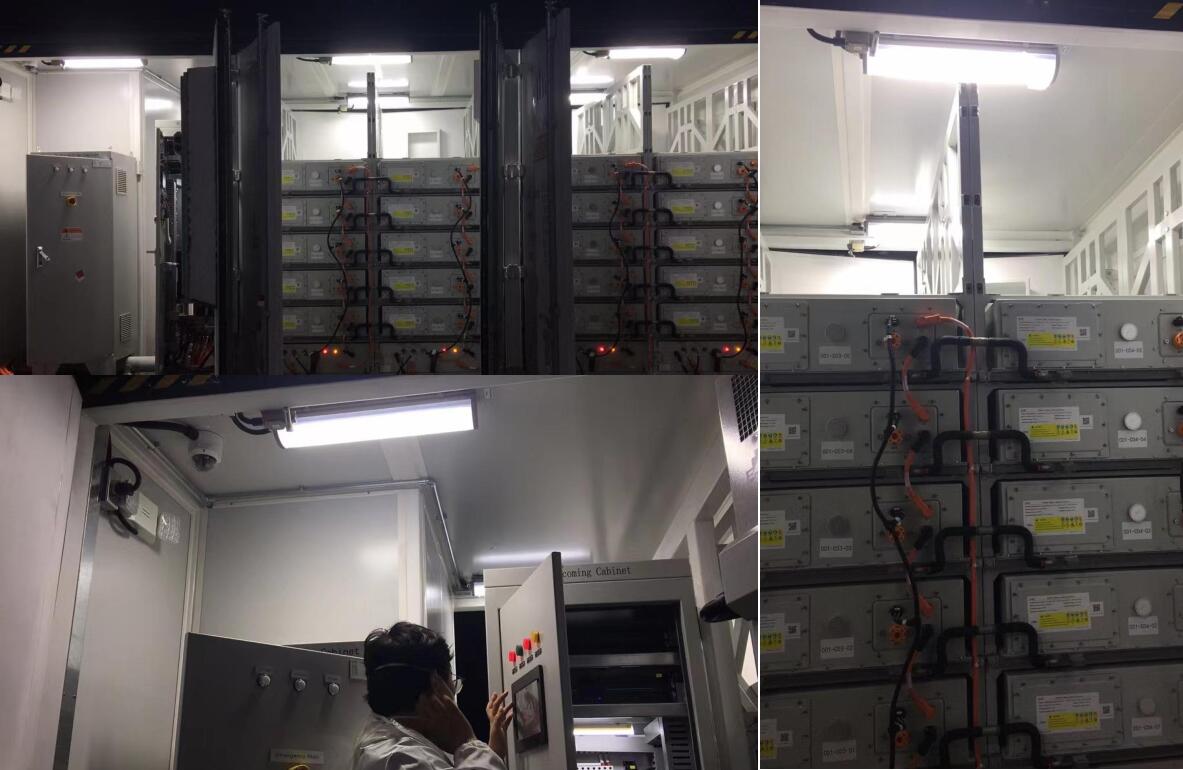
The control room is the command center for production scheduling of the whole plant. The staff can obtain information through various monitoring equipment for scheduling instructions. It is a densely populated area. Working for a long time, especially late at night, people is easy to lose concentration, quality comfortable lighting environment is conducive to relieve visual fatigue, concentration. Considering the environmental characteristics of the central control room and the need for green lighting, we generally recommend CES-EX-LN-02P ceiling-mounted line lights to provide lighting for the central control room. The explosion-proof lights uses a new generation of high brightness LED light source, light efficiency up to 120lm/W, high efficiency, energy saving, uniform light, no stabs, using PC cover can also be anti-glare, good visual effect, conducive to the work site to create a comfortable light environment.
If you need to Dialux Lighting Solution for your control room, please provide us with the CAD drawings, or the dimensions of the room.

New Standard GB/T3836-2021 VS IEC60079 (Explosive Atmospheres)
GB/T3836-2021 refer to China Explosion-Proof standards
IEC60079 refer to International Explosion-Proof standards
With the release and implementation of the new GB/T3836-2021 standard, China's explosion-proof standards are further in line with international explosion-proof standards. The new version of the national explosion-proof standard in the original GB12476, GB25286 standards on the basis of covering the explosive environment equipment design, manufacturing, inspection, selection, installation, inspection, maintenance, repair and site classification and other aspects, using the form of partial standards, including but not limited to the following parts.
Part. 1 to Part .35
GB/T 3836.1-2021 Explosive atmospheres - Part 1: General requirements for equipment
Corresponding IEC 60079-0:2017 Explosive atmospheres - Part 0: General requirements for equipment
GB/T 3836.2-2021 Explosive atmospheres - Part 2: Equipment protected by flameproof enclosure "d"
Corresponding IEC standard: IEC 60079-1:2014 Explosive atmospheres - Part 1: Equipment protected by flameproof enclosure "d"
GB/T 3836.3-2021 Explosive atmospheres Part 3: Equipment protected by increased safety type "e"
Corresponding IEC standard: IEC 60079-7:2015 Explosive atmospheres Part 7: Equipment protected by increased safety type "e"
GB/T 3836.4-2021 Explosive atmospheres - Part 4: Equipment protected by intrinsic safety type "i"
Corresponding IEC standard: IEC 60079-11:2011 Explosive atmospheres Part 11: Equipment protected by intrinsic safety type "i"
GB/T 3836.5-2021 Explosive atmospheres - Part 5: Equipment protected by positive pressure enclosure "p"
Corresponding IEC standard: IEC 60079-2:2014 Explosive atmospheres Part 2: Equipment protected by positive pressure enclosure "p"
GB/T 3836.6-2017 Explosive atmospheres Part 6: Equipment protected by oil immersion type "o"
Corresponding IEC standard: IEC 60079-6:2015 Explosive atmospheres Part 6: Equipment protected by Oil immersion type "o"
GB/T 3836.7-2017 Explosive atmospheres Part 7: Equipment protected by Powder Filling type "q"
Corresponding IEC standard: IEC 60079-5:2015 Explosive atmospheres Part 5: Equipment protected by power filling type "q"
GB/T 3836.8-2021 Explosive atmospheres Part 8: Equipment protected by type "n"
Corresponding IEC standard: IEC 60079-15:2017 Explosive atmospheres Part 15: Equipment protected by type "n"
GB/T 3836.9-2021 Explosive atmospheres Part 9: Equipment protected by Encapsulation type "m"
Corresponding IEC standard: IEC 60079-18:2014 Explosive atmospheres Part 18: Equipment protected by Encapsulation type "m"
GB/T 3836.11-2017 Explosive atmospheres - Part 11: Classification of properties of gases and vapors - Test methods and data
Corresponding IEC standard: IEC 60079-20-1: 2010 Explosive atmospheres Part 20-1: Classification of properties of gases and vapors Test methods and data
GB/T 3836.12-2019 Explosive Atmospheres Part 12: Combustible Dust Substance Properties Test Method
Corresponding IEC Standard: ISO/IEC 80079-20-2:2016 Explosive Atmospheres Part 20-2: Material Properties - Test Method for Combustible Dust
GB/T 3836.13-2021 Explosive atmospheres - Part 13: Repair, overhaul, restoration and modification of equipment
Corresponding IEC standard: IEC 60079-19:2019 Explosive atmospheres Part 19: Repair, overhaul and restoration of equipment
GB 3836.14-2014 Explosive Atmospheres Part 14: Classification of Locations Explosive Gas Atmospheres
Corresponding IEC Standard: IEC 60079-10-1:2008 Explosive Atmospheres Part 10-1: Classification of Hazardous Locations Explosive Gas Atmospheres
GB/T 3836.15-2017 Explosive atmospheres Part 15: Design, selection and installation of electrical installations
Corresponding IEC standard: IEC 60079-14:2007 Explosive atmospheres Part 14: Design, selection and installation of electrical installations
GB/T 3836.16-2017 Explosive atmospheres Part 16: Inspection and maintenance of electrical installations
Corresponding IEC standard: IEC 60079-17:2007 Explosive atmospheres Part 16: Inspection and maintenance of electrical installations
GB/T 3836.17-2019 Explosive atmospheres - Part 17: Equipment protected by positive pressure room "p" and artificial ventilation room "v"
Corresponding IEC standard: IEC 60079-13:2017 Explosive atmospheres Part 13: Equipment protected by positive pressure room "p" and artificial ventilation room "v"
GB/T 3836.18-2017 Explosive atmospheres Part 18: Intrinsically safe electrical systems
Corresponding IEC standard: IEC 60079-25:2010 Explosive atmospheres Part 25: Intrinsically safe electrical systems
GB 3836.20-2010 Explosive Atmospheres Part 20: Equipment with Equipment Protection Level (EPL) Ga
Corresponding IEC standard: IEC 60079-26:2006 Explosive atmospheres Part 26: Equipment with Equipment Protection Level (EPL) Ga
GB/T 3836.21-2017 Explosive atmospheres Part 21: Application of quality system for equipment production
Corresponding IEC standard: ISO/IEC 80079-34:2011 Explosive atmospheres Part 34: Application of equipment production quality system
GB/T 3836.22-2017 Explosive atmospheres Part 22: Protection measures for optical radiation equipment and transmission systems
Corresponding IEC standard: IEC 60079-28:2006 Explosive atmospheres Part 28: Protection measures for optical radiation equipment and transmission systems
GB/T 3836.23-2017 Explosive atmospheres Part 23: Class I EPL Ma equipment for gas and/or coal dust atmospheres
Corresponding IEC standard: none
GB/T 3836.24-2017 Explosive atmospheres Part 24: Equipment protected by special type "s"
Corresponding IEC standard: IEC 60079-33:2012 Explosive atmospheres Part 33: Equipment protected by special type "s"
GB/T 3836.25-2019 Explosive atmospheres Part 25: Requirements for process sealing between flammable process fluids and electrical systems
Corresponding IEC standard: IEC TS 60079-40: 2015 Explosive atmospheres Part 40: Process sealing requirements between flammable process fluids and electrical systems
GB/T 3836.26-2019 Explosive Atmospheres Part 26: Guidance on Electrostatic Hazards
Corresponding IEC standard: IEC TS 60079-32-1:2013 Explosive atmospheres Part 32-1: Guidance on electrostatic hazards
GB/T 3836.27-2019 Explosive atmospheres Part 27: Electrostatic hazard test
Corresponding IEC standard: IEC 60079-32-2:2015 Explosive atmospheres Part 32-2: Electrostatic hazard test
GB/T 3836.28-2021 Explosive atmospheres - Part 28: Non-electrical equipment for explosive atmospheres - Basic methods and requirements
Corresponding IEC standard: ISO 80079-36:2016 Explosive atmospheres Part 36: Basic methods and requirements for non-electrical equipment for explosive atmospheres
GB/T 3836.29-2021 Explosive atmospheres - Part 29: Non-electrical equipment for explosive atmospheres - Structural safety type "c", controlled ignition source type "b", liquid immersion type "k"
Corresponding IEC standard: ISO 80079-37:2016 Explosive atmospheres Part 37: Non-electrical equipment for explosive atmospheres Non-electrical explosion-proof type structural safety type "c", control ignition source type "b", liquid immersion type "k"
GB/T 3836.30-2021 Explosive atmospheres - Part 30: Equipment and components for explosive atmospheres in underground mines
Corresponding IEC standard: ISO/IEC 80079-38:2016 Explosive atmospheres Part 38: Equipment and components for explosive atmospheres in underground mines
GB/T 3836.31-2021 Explosive atmospheres - Part 31: Equipment protected by dust ignition-proof enclosure "t"
Corresponding IEC standard: IEC 60079-31:2013 Explosive atmospheres Part 31: Equipment protected by a dust ignition-proof enclosure "t"
GB/T 3836.32-2021 Explosive atmospheres - Part 32: Electronically controlled spark time limit intrinsically safe systems
Corresponding IEC standard: IEC TS 60079-39: 2015 Explosive atmospheres Part 39: Electronically controlled spark time limit intrinsically safe systems
GB/T 3836.33-2021 Explosive atmospheres Part 33: Equipment for severe working conditions
Corresponding IEC standard: IEC TS 60079-43:2017 Explosive atmospheres Part 43: Equipment for severe working conditions
GB/T 3836.34-2021 Explosive atmospheres - Part 34: Complete sets of equipment
Corresponding IEC standard: IEC TS 60079-46:2017 Explosive atmospheres Part 46: Complete equipment
GB/T 3836.35-2021 Explosive Atmospheres Part 35: Classification of Explosive Dust Atmospheres
Corresponding IEC standard: IEC 60079-10-2: 2015 Explosive atmospheres Part 10-2: Location classification Explosive dust atmospheres
Cold Storage Lighting Design Solution
Cold storage refers to the artificial means to create an environment different from the outdoor temperature or humidity. It is also a constant temperature and humidity storage device for food, liquid, chemicals, medicines, vaccines, scientific experiments and other items. Cold storage is usually located near the shipping port or place of origin. Compared with refrigerators, cold storage has a larger cooling area and a common cooling principle.
Part 1: The composition of cold storage equipment
General cold storage is mostly refrigerated by refrigerator, using liquid (ammonia or freon) with very low temperature gasification as coolant, so that it evaporates under the condition of low pressure and mechanical control, absorbing the heat in the storage, so as to achieve the purpose of cooling. The most commonly used is the compression refrigerator, which is mainly composed of compressor, condenser, throttle valve and evaporation tube. According to the way of evaporation tube device, it can be divided into direct cooling and indirect cooling two kinds. Direct cooling The evaporation tube is installed in the refrigerated warehouse. When the liquid coolant passes through the evaporation tube, it directly absorbs the heat in the warehouse and cools down. Indirect cooling is the suction of the air in the warehouse by the blower into the air cooling device, the air is circled in the cooling device in the evaporation tube after heat absorption, and then sent into the warehouse to cool down. The advantages of air cooling are rapid cooling, uniform temperature in the storage, and the harmful gases such as carbon dioxide produced in the storage process can be taken out of the storage.
Part 2: Cold storage lighting use and requirements
The main characteristics of the cold storage is low temperature, large moisture, freezing phenomenon, so the cold storage lamp must also be used according to the standard protection level, but the cold storage lamp because of the special application environment, long-term life is too short, difficult to maintain the high cost of the problem, whether it is the old cold storage, or a lot of new cold storage or the use of low luminous efficiency, short life incandescent lamp or energy-saving lamp as the warehouse lighting.
The Cold Storage Design Specification by the different state has clear provisions for the electrical lighting system of cold storage, the contents are as follows:
Damp proof incandescent lamps with enclosure protection class IP54 and protective cover should be used for lighting in the cold room. The illumination of the cooling room, cold bonding room, refrigerating room, ice storage room and hall should not be less than 20 lx; The illumination of processing room and packaging room should not be less than 50 lx.
The arrangement of lighting fixtures in the cold room should avoid the ceiling type air cooler (air cooler) and the top row pipe, and the key lights should be distributed in the corridor in the warehouse, and the lights can be evenly arranged in the cargo space.
Because the refrigeration system uses ammonia as the refrigerant, and ammonia is toxic and has explosion risk, according to the "Explosion and Cold storage design and Installation Code" provisions, ammonia compression room and equipment room belong to the hazardous location.

Ammonia gas is lighter than air. In the event of an ammonia leakage accident, ammonia gas will accumulate in the upper space of the ammonia compressor room. Therefore, the selection and wiring of lighting fixtures should be designed in accordance with the requirements of relevant regulations in explosion-hazardous areas.
In addition, the cold storage lamp has a good waterproof level and must reach the IP65 waterproof level (that is, it can completely prevent dust from entering, and at the same time has no effect on low-pressure spraying of rain at any angle). Celsius, according to the requirements of electronic components, is an industrial-grade product, and cold storage lights must resist interference in the power grid.
Part 3: Defects in the use of common cold storage lights
In the past, most cold storage lights used incandescent lamps, energy-saving lamps, ordinary explosion-proof lamps, and so on. Many conventional lights are prone to explosion and damage in some ultra-low temperature emergency storage and quick-freezing storage environment. In addition, the temperature of common lamps is high and the heat is large. Long-term use may corrode the food, cause pollution and endanger the food safety. After the ordinary lamp enters the moisture, the original device will be corroded, and the special products of LED cold storage make a full range of multi-layer sealing treatment on the inside of the lamp.

Ordinary cold storage lamps in cold storage low temperature, wet environment, the general life of the lamp is about 50-60 days, and the overall life of good quality LED cold storage special lights is extended to 3-5 years, greatly improve the life, but also greatly avoid the safety risks caused by wet short circuit.
CESP provide LED cold storage light to many projects, “waterproof”, "dust-proof" and "low temperature resistance". For the hazardous location, it obtained full-certificate such as IECEx ATEX, UL844, CNEx, it allows to be used in dust explosion environment.
Part 4: Cold storage lighting design requirements
For the normal lighting design
- illumination design should be 50 ~ 75lx.
- Selection of lamps
- Ammonia compression room, equipment room lighting should be explosion-proof type.
- lighting control switch should choose flameproof type, or centralized installation in the control room.
- Installation method of lamps
- The height of the machine room is generally more than 6m, and the upper suspension of many process pipes. Therefore, it is recommended to install wall lamps if the width of the equipment room is less than 7m. The width of the equipment room exceeds 10m. Lamps should be suspended from steel cables.
- The lighting line should be laid through the steel pipe with copper core insulated wire with a cross section of no less than 1.5mm2. Installation requirements are the same as those for power wiring. Metal protective pipelines are allowed as protective grounding wires for lighting fixtures.
For emergency lighting design
When the normal working lighting power supply of ammonia compression room and equipment room fails and goes out, in order to ensure the safe production and continued operation of cold storage design and installation personnel can carry out necessary operation and disposal of refrigeration equipment and related valves, emergency lighting needs to be set up. The design and installation requirements of cold storage are as follows:
- Emergency lighting power supply selection
Emergency lighting power supply and normal working lighting power supply should be connected from different low-voltage distribution loops. When conditions do not permit, the emergency lighting power supply is connected to the main switch of the working lighting power supply. But you can't share a master switch.
When the normal power supply fails, the conversion time to the emergency power supply should not be longer than 15 seconds. When explosion-proof emergency lighting fixtures with storage batteries are used, the continuous power supply time should not be less than 30 minutes.
- Selection of lighting fixtures
High intensity gas discharge lamps, such as high pressure mercury lamps and
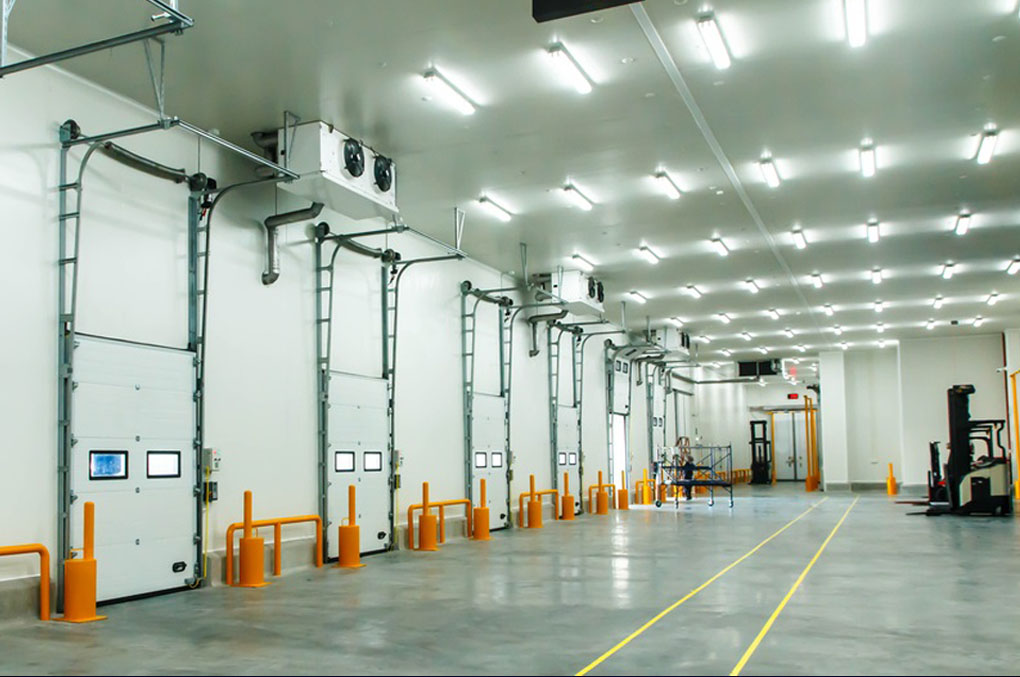
CES-EX-LN-02P 2ft 4ft Explosion Proof Linear Fixture series features a 90 minute emergency backup battery in 12W designed for hazardous environments where Zone 1 and Zone 2 with explosive gas atmosphere or explosive dust atmosphere may be present.
This battery backup lighting fixtures made of the die-cast aluminum and the PC cover. Good heat, and 6J impact resistance.
Installation: pendant, ceiling, pole or more customized.
Adopt to the high light-efficacy LED source, up to 140lm/W, the CCT is 2700K, 3000K, 4000K, 5000K, 5700K, 6500K optional, no flicker, no glare.
The electrophoresis technology and the multiple coats of marine anti-corrosion paint, the all the mounting brackets and accessories are made of 316 stainless steel, UL1598A anti-corrosion standard can for marine location.
Part 5: Cold storage lighting selection recommendation
The selection of cold storage lamp is usually based on the power of the lamp, irradiation area, voltage, material, waterproof level, temperature and humidity, and other parameters to choose, no matter how to choose, cold storage lamp must be low temperature resistance, waterproof, dustproof, crack proof, otherwise the life is very short, the common use scenario of cold storage lamp is as follows:
1. Air-cooled suction ceiling cold storage light
Suction ceiling cold storage light is suitable for air cooling cold storage. Generally, small cold storage can be installed at 10-30W. Common shapes are round, oval, rectangular, square, etc.
2. Aluminum row boom cold storage light
The aluminum bank is suitable for the suspender cold storage light. This kind of aluminum bank suspender is 20cm in standard, and the length of the suspender can be customized according to customer requirements. There are three shapes of long, square and round, all of which are 30W.
3. The suction top height penetrates the cold storage light
The transparent cover cold storage lamp has strong penetration, which is suitable for the cold storage with large fog and humidity, especially the medium temperature and low temperature cold storage.
4. Cold storage production room cold storage light
Production room, working table with cold storage lamp, generally there are two kinds of milk white cover and transparent cover, milk white cover is not dazzling, but penetration is not as transparent cover cold storage lamp. This kind of light is sufficient, illuminate wide, full light, cover many corners, low light failure, long life, lamp failure after a few years is significantly less than the ordinary light source.
5. Cold storage floodlight
Cold storage floodlight has super thick glass mask is not easy to damage, high light transmittance uniform light, soft light, high quality die cast aluminum forging, not easy to deformation, spray paint treatment corrosion resistance, equipped with adjustable bracket, according to the demand to adjust the Angle of light. But no matter how you choose, the cold storage lamp must be "low temperature resistant, waterproof, dustproof, crack proof". Explosion-proof lamps in special areas are essential, otherwise it will bring great safety risks.


